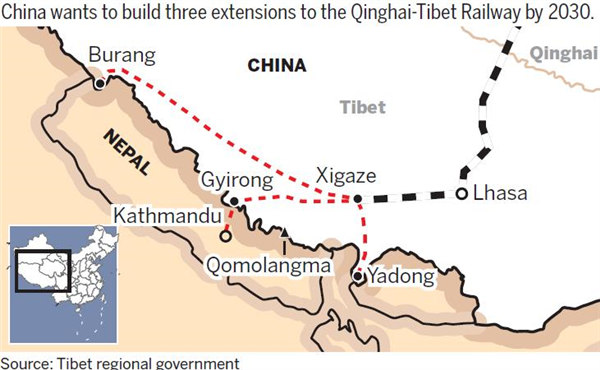China has the technology and experience to build line from Tibet to South Asia, experts say.
A Himalayan train ride at more than 100 kilometers per hour at the foot of the world’shighest snow-capped mountains and oldest glaciers is no longer just a dream, Chineserailway experts say.
With more than 19,000 km of high-speed — up to 350 km per hour — railways, China hasaccumulated the technology and experience to build a rail link between the Tibetantonymous region and the South Asian subcontinent, they say.
The Himalayan railway would start from Xigaze, a city in Tibet, run to Gyirong, a land porton the Chinese border, and extend into Nepal, although it would not be a high-speedrailway, the researchers said on Thursday at a forum in Beijing run by the ChinaTibetology Research Center, a Tibetan studies organization.
In 2006, China built a railway running for more than 1,100 km to connect the highlandregion of Tibet with the rest of the country. In 2014, it built a 250-km rail link betweenLhasa, the Tibet regional capital, and Xigaze, the region’s second-largest city.
Trains run at 100 km per hour throughout the Tibetan rail system, which according toChina’s railway plan for 2016 to 2020, will stretch from Xigaze to Gyirong.
Nepal hopes that China can connect this port with Kathmandu, the Nepalese capital, aspart of the China-Nepal international railway.
China hopes the rail link will boost economic, cultural and religious communication withNepal as part of the Belt and Road Initiative proposed by President Xi Jinping.
“The construction of a railway crossing the Himalayan mountains is now economically andtechnologically feasible,” said Zong Gang, deputy director of the Science and TechnologyDepartment at Beijing University of Technology.
The altitude at Gyirong port is 2,800 meters above sea level, while the Gyirong mountainpass to Nepal lies at about 1,800 meters, making the railway geographically feasible.
In contrast, Lhasa is about 3,700 meters above sea level and the altitude at Xigaze is about3,800 meters.
Losang Jamcan, chairman of the Tibet autonomous region government, said on July 1 thatbuilding rail links is the most powerful way to help Tibet open up to South Asian countries.
After a meeting between Premier Li Keqiang and Nepalese Prime Minister K. P. SharmaOli in March, the two countries said their governments will further discuss construction ofa cross-border railway and also support companies conducting preliminary research.
At least two Chinese companies have shown an interest in developing rail networksconnecting China with Nepal, the Kathmandu Post reported on July 2.
China CAMC Engineering Co has proposed building a 121-km railway linking Kathmanduand Rasuwagadhi, a land port in Nepal facing Gyirong.
China Railway Construction Corp has applied to the Railway Department in Nepal for aKathmandu-Rasuwagadhi railway feasibility study.
Ma Jiali, a researcher at the China Institutes of Contemporary International Relations,said a trans-Himalayan railway would be of great economic value as it could later connectChina, the largest economy in Asia, with India, the continent’s third-largest economy.
He said that landlocked Nepal is willing to have a more convenient link to China because itbelieves that China’s development will offer great opportunities for Nepal.
Zhou Yuhui, a professor at Beijing Jiaotong University who has just returned from a fieldvisit to the China-Nepal border, said, “There are rich tourism resources, including virginforest, canyons and historical relics in Gyirong, which has hardly been developed.
“While bringing tourists and businesses to Gyirong, which will help local people to escapepoverty, the China-Nepal railway will also help … to make people more willing to integrateinto modern life.”
